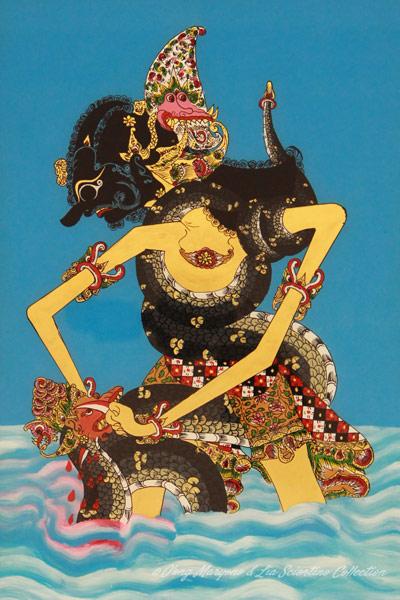| Collection Number | 93 |
| Title | Bimo Suci/ Bhima the pure |
| Time | 1994 |
| Time Acquisition | 1994 |
| Place | Solo, Central Java, indonesia |
| Place of Acquisition | Alun-Alun Kidul, Solo, Central Java, indonesia |
| Name Painter (Place and Year of Birth-Death) |
Unknown |
| Size | 35cm x 50cm |
| Category (Sub-Category) | Epics |
| Current Location | Vietnam Museum of Ethnology (VME) Permanent Exhibition “Indonesian Glass Paintings: The Collection of O‘ong Maryono and Rosalia Sciortino” Link: http://www.vme.org.vn/permanent-exhibitions/ tranh-kinh-indonesia-en-us/ |
| Description | This painting portrays Bima (Bhima), a hero of the epic Mahabharata, who is often portrayed in glass paintings. He is the second child of the five Pandawa brothers and is described as fierce and very strong, with big appearance, but good-hearted (see description by glass painting #92).
Here Bima is fighting with a dragon in the wayang (shadow puppets) play “Bima Suci” (or “Bhima The Pure”). This chronicle tells the adventures of Bima for carrying out the mandate from his teacher, Durna. Bima must dive into the ocean to find the Parwita (pure) water (a symbol of purity and self- authenticity) in the bottom of the ocean representing eternal forgiveness. At first, Bima’s mission is resisted by his family. His mother, Kunti, and the other Pandawa brothers want to protect him and assume, Durna’s command is nonsense. However, Bima follows the mandate and strives to get rid of all hazards and barriers. Bima fights with the sacred white monkey Hanuman, beats the giants, and counters a dragon. The fight with the dragon is often portrayed in glass paintings and represent the fight against villainy as portrayed by the dragon. The killing of the dragon by Bima shows that to achieve purity of life, a human has to control villainy in his heart and mind. Finally, he manages to dive into the ocean where he meets Dewa Ruci, the god of all gods. Bima is ordered to enter Dewa Ruci’s small body, so he can realize that the authenticity/God actually exist inside each human being. Dewa Ruci shows the four primary colours of human (according to Javanese mysticism): red, yellow, black, and white. Those colours liken the elements of the world and of the human body. To achieve authenticity, every human should control the mundane appetence. (symbolized by red, yellow, and black) and accentuate the white one as a symbol of purity and peace of mind. Anyone who could do it, will taste the perfect life, “the unity of creature with The Creator” or of the micro-cosmos with the macro-cosmos. Various documents view the “Bima Suci” saga as the trail of Sunan Kalijaga, the most famous of the Wali songo (nine propagators of Islam in Java in the 14th century considered sacred/’saints’) incarnating his spiritual experience in wayang, or shadow puppets performance. (Quoted and adapted from https://republika.co.id/berita/en/speak-out/15/06/08/nplgv5-life-lessons-from-bima-suci) |

